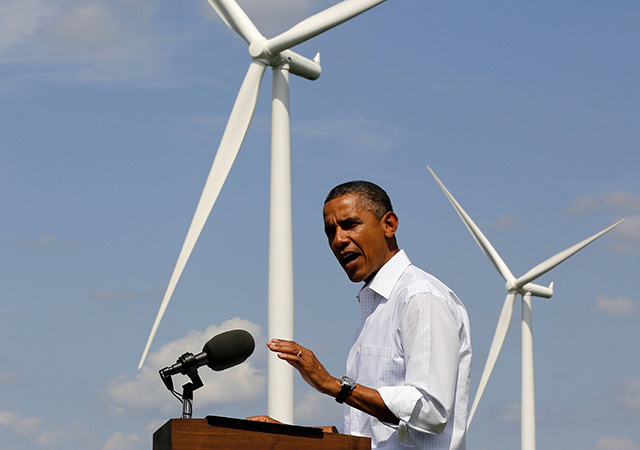
President Barack Obama is set to take his boldest step to halt the rise of the oceans and stop the warming of the planet.
It won’t be enough unless the rest of the world follows.
Trimming carbon emissions from U.S. power plants by 25 percent in coming decades, as Obama is said to be proposing, would be more than overwhelmed by increases in China and India where coal-fired power plants are springing up and new cars are rolling out of showrooms.
“It’s not a magic bullet,” Alden Meyer, director of strategy and policy at the Union of Concerned Scientists, said in an interview.
And while making electricity creates 40 percent of the greenhouse gases in the U.S., cutting it as Obama proposes will not come close to meeting the global reduction scientists say is necessary to reverse warming. For one thing, the amount of the U.S. cuts would be replaced more than three times over by projected increases in China alone.
Persuading developing countries to forgo the benefits of cheap coal power and economic growth won’t be easy. But the power plant rules — along with other Obama initiatives, such as convincing automakers to improve fuel efficiency — give the U.S. something to show in Paris next year where a conference is planned to negotiate a global agreement on carbon pollution.
Were U.S. emissions cut to zero, “global emissions would continue to increase,” Robert Stavins, director of Harvard University’s Environmental Economics Program, said in an e-mail. “So, the direct impacts of the new power plant rules on atmospheric greenhouse-gas concentrations will be small.”
In fact, both critics of the effort, such as the U.S. Chamber of Commerce, and environmentalists pressing for quicker action make a similar argument: Whatever the Obama administration does at home will be dwarfed by worldwide trends.
Burning fossil fuels in the U.S. released 5.3 billion metric tons of greenhouse gases in 2012. China emitted 9.0 billion tons and by 2020 is forecast by the U.S. Energy Department to reach 11.5 billion metric tons, while the U.S. stays flat. India, Indonesia and other developing nations are expected to grow, as well.
Were U.S. emissions cut to zero, “global emissions would continue to increase,” Robert Stavins, director of Harvard University’s Environmental Economics Program, said in an e-mail. “So, the direct impacts of the new power plant rules on atmospheric greenhouse-gas concentrations will be small.”
According to the World Resources Institute in Washington, 1,200 coal-fired plants are proposed globally, with more than three-quarters of those planned for India and China alone. If all are built, which WRI says is unlikely, that would add more than 80 percent to existing capacity.
All of this doesn’t mean Obama’s effort won’t matter.
The regulation in the U.S., once it is fully implemented in the coming years, could spur investments in carbon-capture equipment or other technology that reduces carbon pollution, said Armond Cohen, the president of the Clean Air Task Force, an environmental group supportive of Obama’s effort. And once those technologies are introduced in the U.S., they can spread.
“You start creating markets like this, and investors pile in,” Cohen said in an interview. “The real significance of this rule may not be in the U.S., it may be in China or Indonesia.”
And this isn’t the only action taken by Obama. His administration already got automakers to agree to new fuel efficiency standards, which were at that point the biggest single effort by any nation to curtail emissions, according to Dan Becker, director of the Safe Climate Campaign, a Washington watchdog group.
The administration launched an effort to curb methane leaks, and agreed with China on measures to cut the use of hydrofluorocarbons, a less ubiquitous but more potent greenhouse gas.
All those steps together — along with the boom in natural gas — mean the nation may still meet Obama’s goal to cut greenhouse-gases by 2020 to 17 percent below 2005 levels. With those cuts in place, the U.S. might now be able to drive global climate talks toward a long-elusive conclusion, Stavins and other analysts say.
“The reason this is important is only partly because of the carbon reductions,” Dallas Burtraw, a senior fellow at Resources for the Future, an environmental research organization in Washington. “It leverages the U.S. back into a global leadership position on climate.”
Leadership is needed. While international negotiators have tried and failed to reach a global deal to impose limits on greenhouse-gas emissions, which scientists blame for climate change, the problem has intensified.
Global average temperatures have already warmed by about 0.8 degrees Celsius (1.4 degrees Fahrenheit) since 1850, the Intergovernmental Panel on Climate Change said in September. It projected temperatures will rise by as much as another 4.8 degrees this century.
A U.S. government advisory panel said this month that global warming is already prompting increases in coastal flooding, heavier rainstorms and more intense wildfire seasons. And more woes are coming unless curbs in fossil fuel use are pursued, and communities begin to try to mitigate the threats, it said.
And the effects on the U.S. are likely to be among the least extreme globally, as poor nations with coastlines such as Cambodia, Vietnam, the Philippines and Nigeria face the greatest threats from stronger storms and sea rise associated with global warming, according to a report this week from Standard & Poor’s.
“The poorest countries in the world are those most impacted by climate change,” said Michael Wilkins, managing director of the credit ratings agency.
